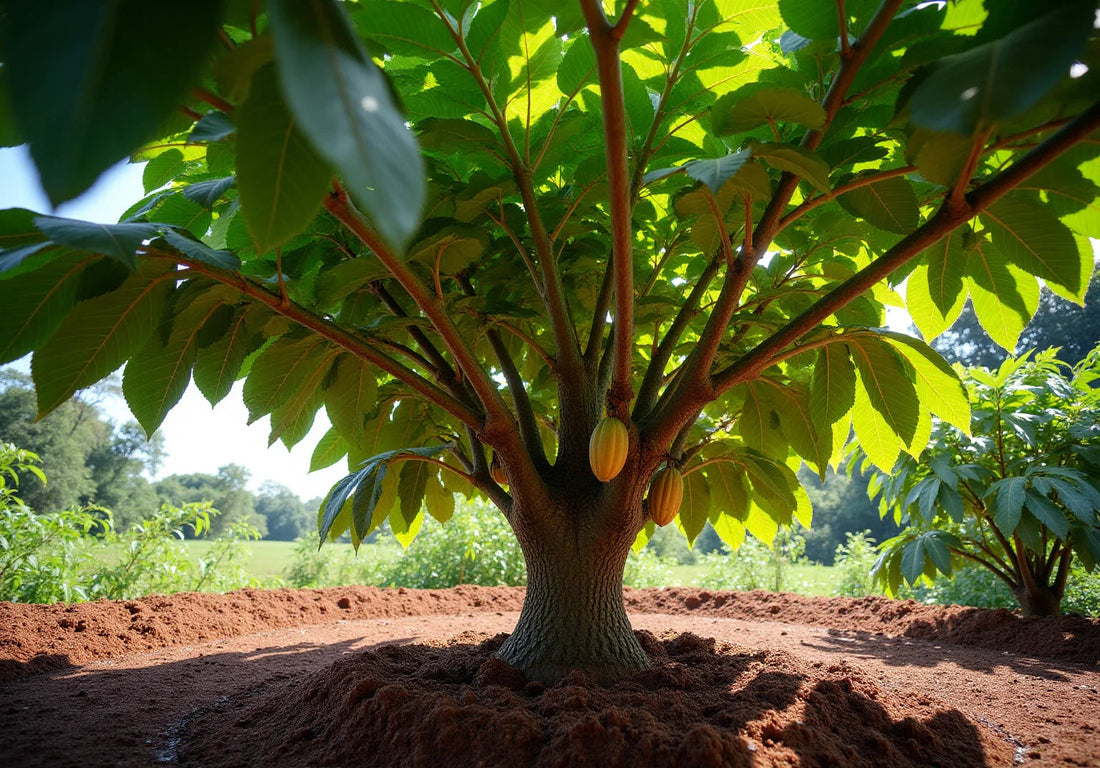
How to Grow Forastero Cacao Tree
Share
The Forastero cacao tree is renowned for its resilience and prolific yield, making it a vital player in the world of chocolate production. This robust variety offers aspiring growers a unique opportunity to explore the art of cultivation, revealing the secrets to optimal growth and bountiful harvests. However, the journey of nurturing these trees is not without its challenges. It is essential to understand the key steps necessary to ensure that the Forastero cacao trees not only survive but truly thrive in their environment.
🛒 Buy your own Forastero Cacao Tree at Everglades Farm - shipped directly from Florida.
Understand the Forastero Cacao Tree Characteristics
The cocoa plant (Theobroma cacao) is renowned for its durability and abundant production, making it a preferred selection among cocoa growers. Below are some key characteristics that highlight its features, advantages, and benefits:
- Size and Growth: Forastero trees typically reach heights of 20 to 30 feet, developing a dense canopy that offers shade to their lower branches. They begin to branch out at around 5 to 6 feet tall, establishing a robust structure early in their growth.
- Climate Requirements: This variety flourishes in warm, humid environments, ideally within temperature ranges of 70°F to 90°F (21°C to 32°C) and humidity levels exceeding 80%. It is sensitive to frost, necessitating protection from temperatures below 60°F (15°C).
- Soil Preferences: Cacao plants of the Forastero variety thrive in nutrient-rich, well-draining earth that is somewhat acidic, with a pH ranging from 5.5 to 7.0. Loamy soil that retains moisture without becoming waterlogged is particularly beneficial for their growth.
- Pest and Disease Resistance: While generally resilient, these cacao plants can encounter difficulties from pests like cocoa pod borers and ailments such as black pod rot. Awareness of these vulnerabilities is crucial for effective management and ensuring healthy growth.
Read: Types of Cacao Chocolate Tree
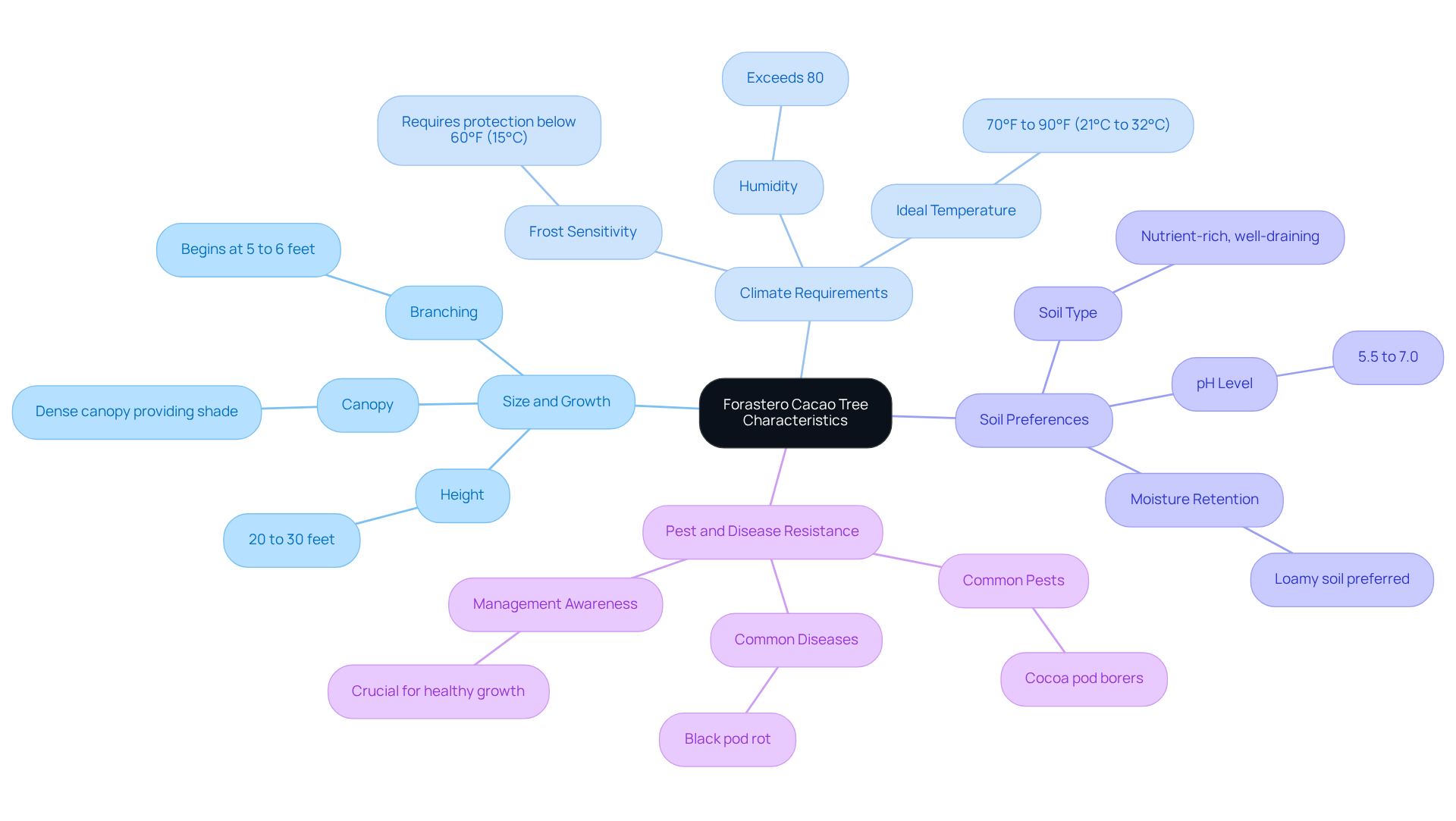
Prepare the Ideal Planting Environment
To prepare the ideal planting environment for your Forastero cacao tree, follow these steps:
-
Choose the Right Location: Select a site that receives partial shade, ideally near taller plants or structures that can provide protection from strong winds. Avoid areas with direct, harsh sunlight, as this can scorch the leaves. Cacao trees thrive in consistent temperatures between 65-90°F (18-32°C).
-
Ground Preparation: Test the pH of the earth to ensure it falls between 5.0 and 7.0 in the top 10-20cm. High organic matter levels of at least 3% are preferable for the production of forastero cacao tree. Enhance the earth with organic material, such as compost or well-decomposed manure, to boost fertility and drainage. If the ground is too compact, consider tilling it to improve aeration.
-
Watering Setup: Ensure access to a reliable water source, as cacao trees require consistent moisture, needing about 60 inches (1,500 mm) of rain annually. Consider installing a drip irrigation system to maintain sufficient ground moisture without waterlogging.
-
Mulching: Apply a layer of organic mulch around the planting area to help retain soil moisture, suppress weeds, and regulate soil temperature. This practice not only aids the forastero cacao tree but also enhances the overall well-being of the planting environment.
By following these steps, you can create a nurturing atmosphere that fosters the development of your variety, ensuring it flourishes in your garden. Remember, as Thomas Fuller stated, "He that plants vegetation loves others besides himself," emphasizing the significance of caring for our environment.
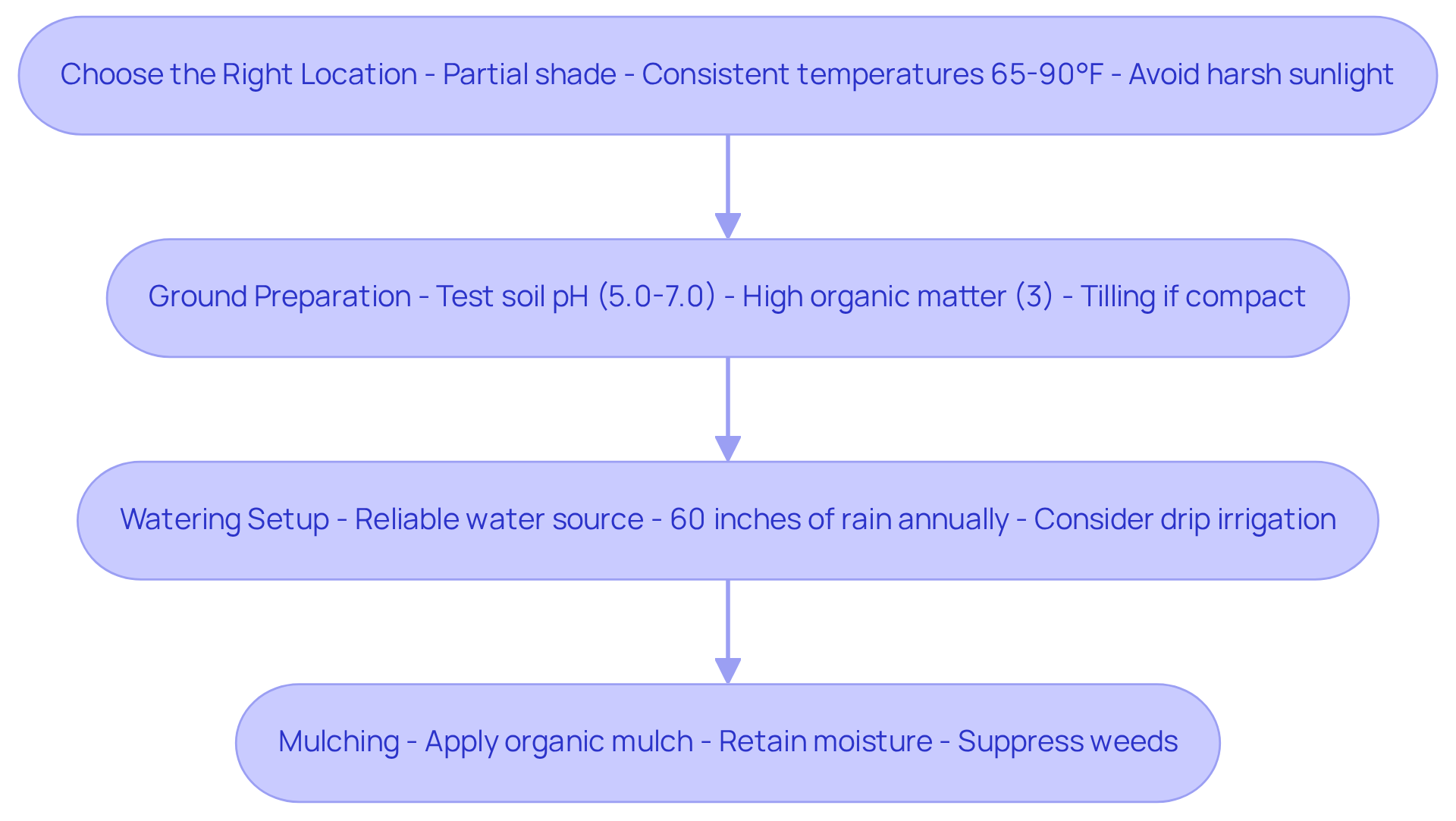
Plant the Forastero Cacao Tree
To successfully plant your Forastero cacao tree and Soursop tree, follow these essential steps:
- Dig the Hole: Create a hole that is three times the diameter and twice the depth of the root ball. This provides sufficient space for the roots to grow into the surrounding ground, encouraging healthy development.
- Position the Plant: Gently take the plant out of its container, taking care to avoid harming the roots. Position the sapling in the middle of the hole, ensuring that the top of the root ball is even with the surrounding earth to promote adequate drainage.
- Backfill the Hole: Refill the hole with the earth you previously removed, packing it down lightly to eliminate air pockets. It’s crucial to refrain from adding fertilizer at this stage, as it can harm the delicate roots.
- After planting, irrigate the plant deeply to help settle the ground around the roots. Keep uniform dampness in the ground for the initial weeks to aid the plant as it acclimates to its new surroundings.
Additionally, when planting tropical fruit plants like Soursop and those from the forastero cacao tree, ensure that the soil composition includes about 50% perlite or coarse sand for proper drainage, as both varieties flourish in well-draining soil. The optimal temperature range for cocoa plants is between 65-85°F, so keep these conditions in mind when choosing a planting site.
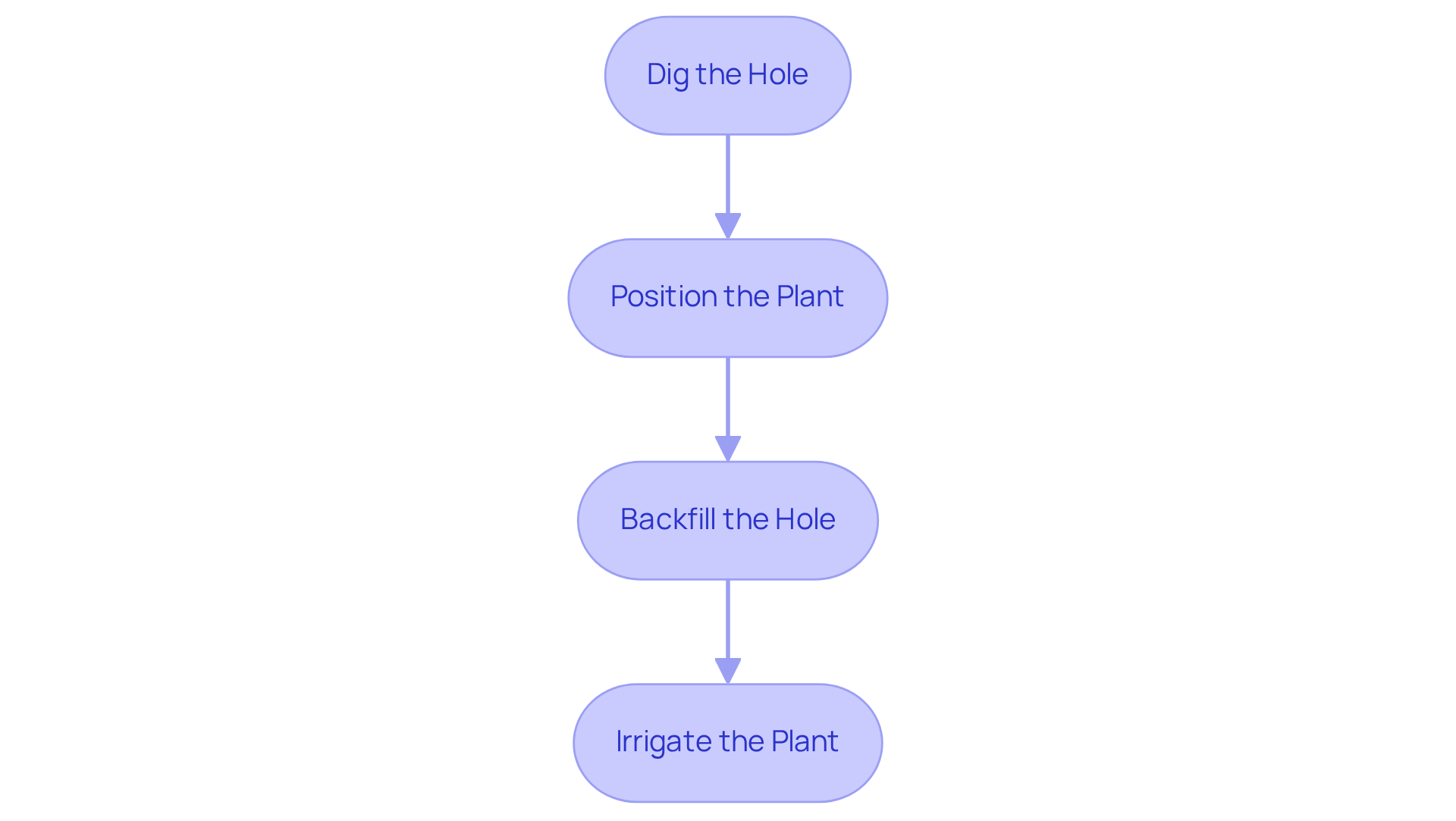
Maintain and Care for Your Cacao Tree
To effectively maintain and care for your Forastero cacao tree, it is essential to follow these practices:
-
Watering: Provide 1-2 inches of water weekly, especially during dry spells. Deep watering is crucial for promoting strong root development, ensuring the plant flourishes. As Chris Kilham notes, "After water, cocoa is the single healthiest substance you can put in your mouth," emphasizing the importance of proper care.
-
Fertilization: Apply a balanced fertilizer with a slightly higher nitrogen content twice a year—once in spring and again in fall. This approach promotes vigorous growth and enhances fruit production. Remember, cocoa plants take about three years to mature and begin producing cocoa pods, so patience is key.
-
Pruning: Regularly trim your cocoa plant to remove dead or diseased branches, which enhances air circulation within the canopy. This practice not only helps prevent fungal diseases but also encourages better fruit yield.
-
Pest and Disease Management: Vigilantly monitor your plant for pests like cocoa pod borers and diseases such as black pod rot. Employ organic pest control methods and maintain cleanliness in the planting area to minimize infestation risks.
Additionally, ensure that your cocoa plant is cultivated in optimal temperatures between 18-21°C and 30-32°C for peak health and productivity. By adhering to these guidelines, you can ensure the health and productivity of your forastero cacao tree, which will ultimately lead to a fruitful harvest. Everglades Farm emphasizes quality in their shipping practices, using moisture barriers to maintain soil integrity during transit.
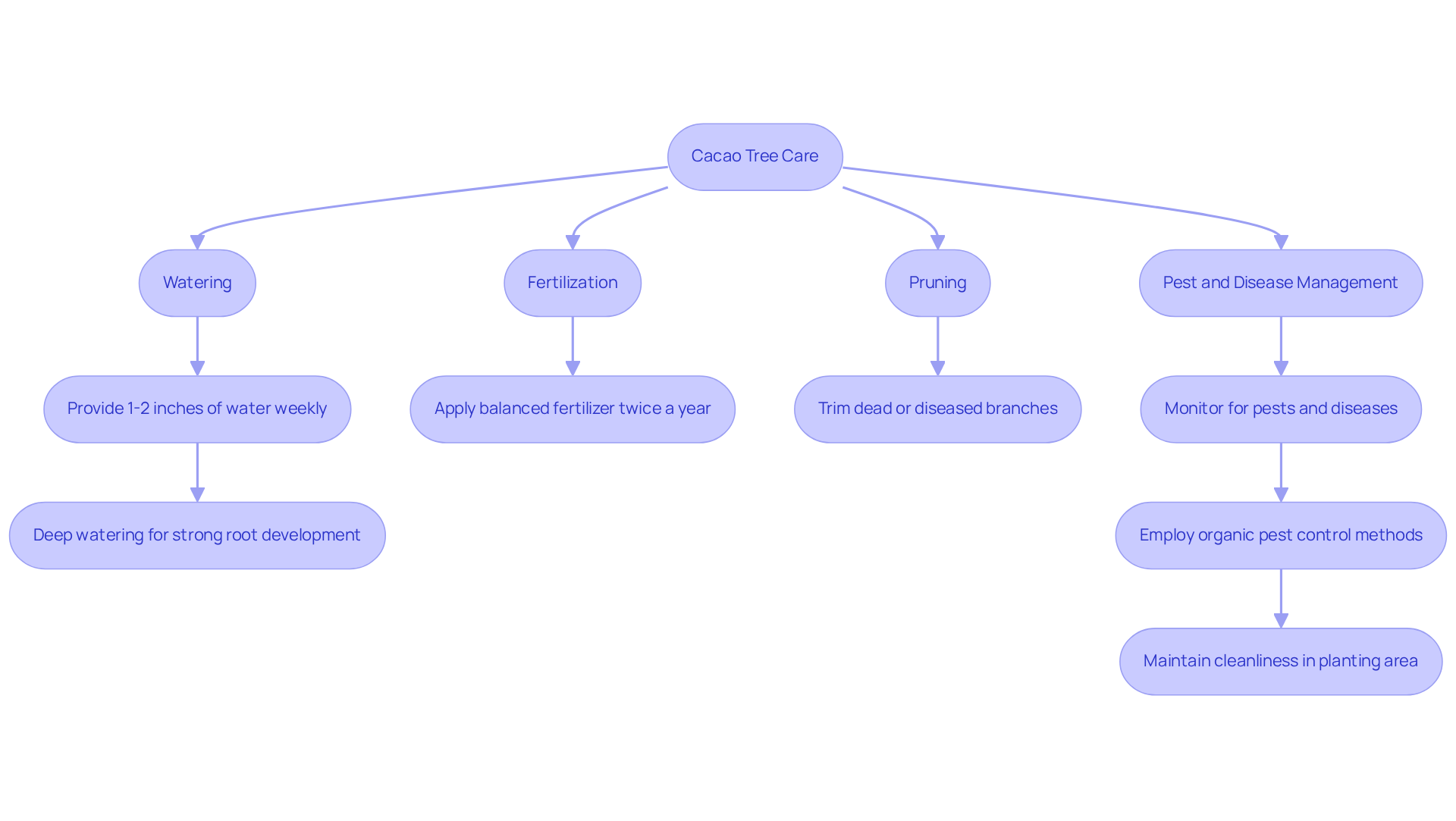
Conclusion
Successfully cultivating the Forastero cacao tree requires an understanding of its unique characteristics and the provision of an optimal growth environment. This guide outlines essential steps, from preparing the planting site to ongoing care, ensuring that growers can effectively nurture their cacao trees and achieve a bountiful harvest.
Key points discussed include:
- The importance of selecting an appropriate location that offers partial shade.
- Preparing nutrient-rich soil.
- Implementing a consistent watering regimen.
Additionally, comprehending the specific needs for pest management and fertilization can significantly influence the health and productivity of the Forastero cacao tree. By adhering to these detailed practices, growers can promote strong root development and enhance fruit production.
Ultimately, the journey of growing the Forastero cacao tree transcends mere crop cultivation; it fosters a deeper connection to nature and sustainable practices. Embracing these methods not only leads to a fruitful yield but also contributes to environmental preservation. For those eager to embark on this rewarding endeavor, the time to start nurturing your Forastero cacao tree is now.
Cultivate Your Own Cacao Paradise Today!
Start your journey with Everglades Farm and enjoy a bountiful harvest of delicious cacao while nurturing nature.
🛒 Explore Cacao Trees Collections
Frequently Asked Questions
What are the main characteristics of the Forastero cacao tree?
The Forastero cacao tree is known for its durability and abundant production. It typically reaches heights of 20 to 30 feet and develops a dense canopy that provides shade to its lower branches.
What are the ideal climate conditions for growing Forastero cacao?
Forastero cacao trees thrive in warm, humid environments with temperatures ranging from 70°F to 90°F (21°C to 32°C) and humidity levels exceeding 80%. They are sensitive to frost and require protection from temperatures below 60°F (15°C).
What type of soil is best for Forastero cacao plants?
Forastero cacao plants prefer nutrient-rich, well-draining soil that is somewhat acidic, with a pH ranging from 5.5 to 7.0. Loamy soil that retains moisture without becoming waterlogged is particularly beneficial for their growth.
Are Forastero cacao trees resistant to pests and diseases?
While Forastero cacao trees are generally resilient, they can face challenges from pests such as cocoa pod borers and diseases like black pod rot. Being aware of these vulnerabilities is important for effective management and ensuring healthy growth.


